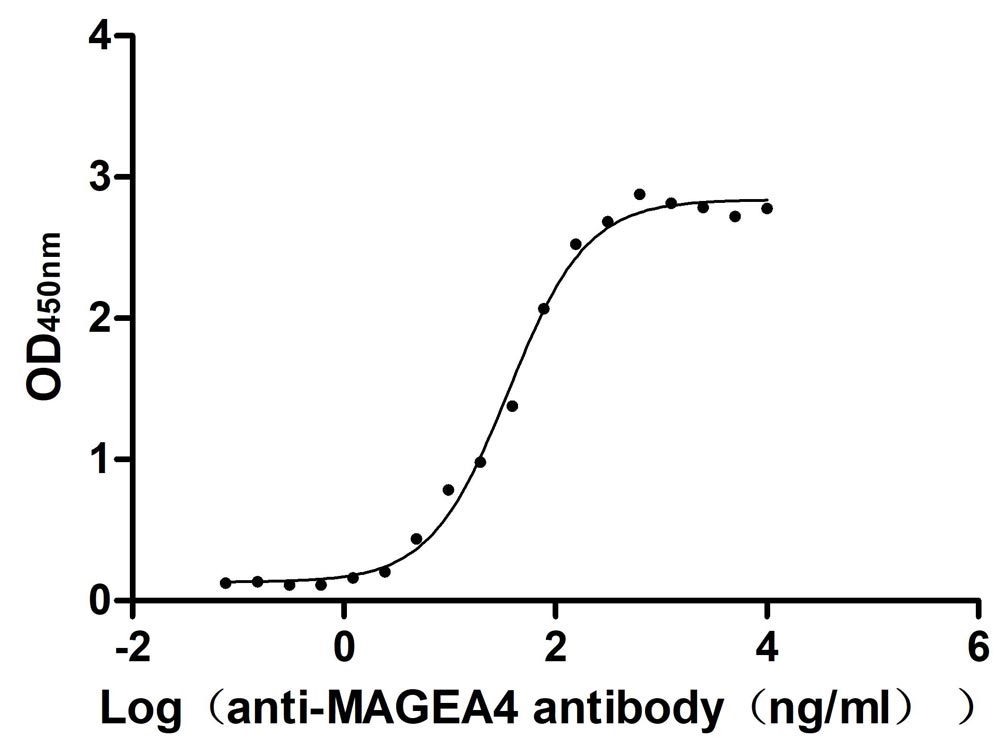Recombinant Human H (+)/Cl (-) exchange transporter 7 (CLCN7), partial
-
中文名稱:Recombinant Human H(+)/Cl(-) exchange transporter 7(CLCN7) ,partial
-
貨號:CSB-YP005486HU
-
規格:
-
來源:Yeast
-
其他:
-
中文名稱:Recombinant Human H(+)/Cl(-) exchange transporter 7(CLCN7) ,partial
-
貨號:CSB-EP005486HU
-
規格:
-
來源:E.coli
-
其他:
-
中文名稱:Recombinant Human H(+)/Cl(-) exchange transporter 7(CLCN7) ,partial
-
貨號:CSB-EP005486HU-B
-
規格:
-
來源:E.coli
-
共軛:Avi-tag Biotinylated
E. coli biotin ligase (BirA) is highly specific in covalently attaching biotin to the 15 amino acid AviTag peptide. This recombinant protein was biotinylated in vivo by AviTag-BirA technology, which method is BriA catalyzes amide linkage between the biotin and the specific lysine of the AviTag.
-
其他:
-
中文名稱:Recombinant Human H(+)/Cl(-) exchange transporter 7(CLCN7) ,partial
-
貨號:CSB-BP005486HU
-
規格:
-
來源:Baculovirus
-
其他:
-
中文名稱:Recombinant Human H(+)/Cl(-) exchange transporter 7(CLCN7) ,partial
-
貨號:CSB-MP005486HU
-
規格:
-
來源:Mammalian cell
-
其他:
產品詳情
-
純度:>85% (SDS-PAGE)
-
基因名:CLCN7
-
Uniprot No.:
-
別名:Chloride channel protein 7; CLC 7; ClC-7; ClC7; CLCN7; CLCN7_HUMAN; FLJ26686; FLJ39644; FLJ46423; H(+)/Cl(-) exchange transporter 7; OPTA2; OPTB4
-
種屬:Homo sapiens (Human)
-
蛋白長度:Partial
-
蛋白標簽:Tag?type?will?be?determined?during?the?manufacturing?process.
The tag type will be determined during production process. If you have specified tag type, please tell us and we will develop the specified tag preferentially. -
產品提供形式:Lyophilized powder
Note: We will preferentially ship the format that we have in stock, however, if you have any special requirement for the format, please remark your requirement when placing the order, we will prepare according to your demand. -
復溶:We recommend that this vial be briefly centrifuged prior to opening to bring the contents to the bottom. Please reconstitute protein in deionized sterile water to a concentration of 0.1-1.0 mg/mL.We recommend to add 5-50% of glycerol (final concentration) and aliquot for long-term storage at -20℃/-80℃. Our default final concentration of glycerol is 50%. Customers could use it as reference.
-
儲存條件:Store at -20°C/-80°C upon receipt, aliquoting is necessary for mutiple use. Avoid repeated freeze-thaw cycles.
-
保質期:The shelf life is related to many factors, storage state, buffer ingredients, storage temperature and the stability of the protein itself.
Generally, the shelf life of liquid form is 6 months at -20°C/-80°C. The shelf life of lyophilized form is 12 months at -20°C/-80°C. -
貨期:Delivery time may differ from different purchasing way or location, please kindly consult your local distributors for specific delivery time.Note: All of our proteins are default shipped with normal blue ice packs, if you request to ship with dry ice, please communicate with us in advance and extra fees will be charged.
-
注意事項:Repeated freezing and thawing is not recommended. Store working aliquots at 4°C for up to one week.
-
Datasheet :Please contact us to get it.
相關產品
靶點詳情
-
功能:Slowly voltage-gated channel mediating the exchange of chloride ions against protons. Functions as antiporter and contributes to the acidification of the lysosome lumen and may be involved in maintaining lysosomal pH. The CLC channel family contains both chloride channels and proton-coupled anion transporters that exchange chloride or another anion for protons. The presence of conserved gating glutamate residues is typical for family members that function as antiporters.
-
基因功能參考文獻:
- In this study, whole exome sequencing (WES) was successfully used in six patients with malignant infantile osteopetrosis (MIOP) and identified mutations in four MIOP-related genes (CLCN7, TCIRG1, SNX10, and TNFRSF11A). PMID: 27187610
- The present study revealed three novel mutations, showed the dense but brittle sclerotic bones of an autosomal dominant osteopetrosis type II (OPTA2) patient, characterized OPTA2 symptoms from benign to fatal and reported a rare intermediate case of autosomal recessive 4 in a Chinese population. PMID: 28975865
- we identified a CLCN7 mutation in a family with autosomal dominant osteopetrosis, RTA, renal stones, epilepsy, and blindness. PMID: 27540713
- present findings suggest that the novel missense mutations V289L and A542V in the CLCN7 gene were responsible for autosomal dominant osteopetrosis (type II) in the two Chinese families. PMID: 26056022
- Exome sequencing and Sanger sequencing were conducted in Han Chinese family members, some of whom had typical osteopetrosis, and a novel missense variant c.2350A>T (p.R784W) in the chloride channel 7 gene (CLCN7) was identified. PMID: 27325559
- The present study identified seven novel mutations of the CLCN7 gene and reported the first case of intermediate autosomal recessive osteopetrosis. with compound heterozygous mutation in the Chinese population. PMID: 26395888
- study demonstrates a wide heterogeneity in the progression of the phenotypes and expanded the mutational spectrum for the CLCN7 gene PMID: 26477479
- the unusual clinical presentation observed in our patient with a mild clinical onset evolving towards a more serious clinical picture, is associated to two novel mutations on CLCN7 gene. PMID: 25410126
- Results show that ClC-7 is strongly expressed in OUMS-27,a chondrocyte cell line and is responsible for Cl- current. Its downregulation during the hypoosmotic stress accompanying osteoarthritis progression is part of the complex etiology of the disease. PMID: 25943117
- analysis demonstrates that CLCN7 and TCIRG1 mutations differentially affect bone matrix mineralization, and that there is a need to modify the current classification of osteopetrosis PMID: 24108692
- recurrent p.Gly215Arg mutation and novel missense mutations p.Ala299Val and p.Trp319Arg in the CLCN7 gene were responsible for these three Chinese ADO-II families. PMID: 23953223
- ClC-7 does not appear to be crucially involved in gastric acid secretion, which explains the absence of an osteopetrorickets phenotype in CLCN7-related osteopetrosis. PMID: 24103576
- Eight mutations, including two reported mutations (R767W and E798FS) and six novel mutations (E313K, A316G, R743W, G741R, W127G and S290F), were detected in the CLCN7 gene from 12 living autosomal dominant osteopetrosis type II patients. PMID: 21947783
- The authors show that both the aminoterminus and transmembrane span of the Ostm1 beta-subunit are required for ClC-7 Cl(-)/H(+)-exchange, whereas the Ostm1 transmembrane domain suffices for its ClC-7-dependent trafficking to lysosomes. PMID: 21527911
- Rat G213R ClC-7 is the analogue of human G215R ClC-7 responsible for autosomal dominant osteopetrosis type II. PMID: 20830208
- Elevated serum LDH isoenzymes and AST indicate a disturbance (of uncertain clinical significance) within multiple extraosseous tissues when there is CLCN7 deficiency. PMID: 20499337
- We report on the fatal clinical course of a 3 year old male Turkish patient suffering from osteopetrosis caused by a homozygous mutation in the chloride channel gene ClCN7 with developing pancytopenia and severe neurological impairment. PMID: 19904698
- That the CLCN7 mutations provoke a phenotype as severe as the one caused by TCIRG1 loss of function suggests the affected residues to be crucial for the function of the ClC-7 chloride channel or chloride/proton-exchanger PMID: 20424301
- The characterization of 25 unpublished patients has resulted in the identification of 20 novel mutations, including 11 missense mutations, 6 causing premature termination, 1 small deletion and 2 putative splice site defects and clinical heterogeneity. PMID: 19953639
- clcn7 gene mutation is associated with intermediate autosomal recessive osteopetrosis PMID: 12522560
- mutations in the CICN7 gene are responsible for autosomal dominant osteopetrosis, type II, an uncommon sclerosing bone disorder PMID: 12929941
- ClCN7 mutations have roles in severe recessive, dominant, and intermediate osteopetrosis PMID: 14584882
- ClC-7 has a role in causing autosomal dominant osteopetrosis type II PMID: 15111300
- The study indicates that the V418M polymorphism of CLCN7 contributes to the genetic regulation of femoral neck BMD in women. PMID: 16234969
- Significant association of CLCN7 polymorphisms with the variance of bone density in postmenopausal women with osteopetrosis. PMID: 16368748
- Autosomal dominant osteopetrosis caused by mutations in the CLCN7 gene is a frequently symptomatic disease manifested by a high rate of fracture, osteomyelitis, visual loss, and occasional bone marrow failure. PMID: 17164308
- ClC-7 is a Cl-/H+ antiporter; it constitutes the major Cl- permeability of lysosomes, and it is important in lysosomal acidification. PMID: 18449189
- Genetic variation in the CLCN7 gene is not a major contributor to the variability in peak BMD at the femoral neck and lumber spine in healthy premenopausal white women and in white men PMID: 18755304
- These data demonstrate that ClC-7 is essential for bone resorption, via its role in acidification of the lysosomes and resorption lacunae in osteoclasts PMID: 19070589
- Findings suggest that the novel Glu798FS mutation in exon 25 and R767W in exon 24 in the CLCN7 gene were responsible for autosomal dominant osteopetrosis (type II) in two Chinese patients. PMID: 19288050
- Mutations in TCIRG1, OSTM1, ClCN7, and TNFRSF11A genes were detected in nine, three, one, and one patientswith infantile malignant osteopetrosis, respectively. PMID: 19507210
- results suggest that osteoclastic ClC7 Cl(-) channels are activated under extracellar acidification and suppressed in Clcn7 mutant associated with autosomal osteopetrosis type II during bone resorption. PMID: 19543743
顯示更多
收起更多
-
相關疾病:Osteopetrosis, autosomal recessive 4 (OPTB4); Osteopetrosis, autosomal dominant 2 (OPTA2); Osteopetrosis, autosomal recessive 2 (OPTB2)
-
亞細胞定位:Lysosome membrane; Multi-pass membrane protein.
-
蛋白家族:Chloride channel (TC 2.A.49) family, ClC-7/CLCN7 subfamily
-
組織特異性:Brain and kidney.
-
數據庫鏈接:
Most popular with customers
-
Recombinant Human B- and T-lymphocyte attenuator (BTLA), partial (Active)
Express system: Mammalian cell
Species: Homo sapiens (Human)
-
Recombinant Human Melanoma-associated antigen 4 (MAGEA4) (Active)
Express system: Mammalian cell
Species: Homo sapiens (Human)
-
Recombinant Dog Angiopoietin-2 (ANGPT2) (Active)
Express system: Mammalian cell
Species: Canis lupus familiaris (Dog) (Canis familiaris)
-
Recombinant Mouse Claudin-18.2 (Cldn18.2)-VLPs (Active)
Express system: Mammalian cell
Species: Mus musculus (Mouse)
-
Recombinant Mouse Cytotoxic and regulatory T-cell molecule (Crtam), partial (Active)
Express system: Mammalian cell
Species: Mus musculus (Mouse)
-
Recombinant Human Carcinoembryonic antigen-related cell adhesion molecule 8(CEACAM8) (Active)
Express system: Mammalian cell
Species: Homo sapiens (Human)
-
Recombinant Human Tumor necrosis factor ligand superfamily member 15(TNFSF15) (Active)
Express system: Mammalian cell
Species: Homo sapiens (Human)
-
Express system: Mammalian cell
Species: Homo sapiens (Human)





-AC1.jpg)


-AC1.jpg)










